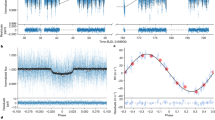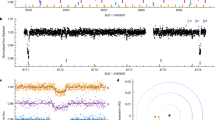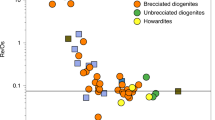Abstract
Earth, Venus, Mars and some extrasolar terrestrial planets1 have a mass and radius that is consistent with a mass fraction of about 30% metallic core and 70% silicate mantle2. At the inner frontier of the Solar System, Mercury has a completely different composition, with a mass fraction of about 70% metallic core and 30% silicate mantle3. Several formation or evolution scenarios are proposed to explain this metal-rich composition, such as a giant impact4, mantle evaporation5 or the depletion of silicate at the inner edge of the protoplanetary disk6. These scenarios are still strongly debated. Here, we report the discovery of a multiple transiting planetary system (K2-229) in which the inner planet has a radius of 1.165 ± 0.066 Earth radii and a mass of 2.59 ± 0.43 Earth masses. This Earth-sized planet thus has a core-mass fraction that is compatible with that of Mercury, although it was expected to be similar to that of Earth based on host-star chemistry7. This larger Mercury analogue either formed with a very peculiar composition or has evolved, for example, by losing part of its mantle. Further characterization of Mercury-like exoplanets such as K2-229 b will help to put the detailed in situ observations of Mercury (with MESSENGER and BepiColombo8) into the global context of the formation and evolution of solar and extrasolar terrestrial planets.
This is a preview of subscription content, access via your institution
Access options
Access Nature and 54 other Nature Portfolio journals
Get Nature+, our best-value online-access subscription
$29.99 / 30 days
cancel any time
Subscribe to this journal
Receive 12 digital issues and online access to articles
$119.00 per year
only $9.92 per issue
Buy this article
- Purchase on Springer Link
- Instant access to full article PDF
Prices may be subject to local taxes which are calculated during checkout



Similar content being viewed by others
References
Dressing, C. D. et al. The mass of Kepler-93b and the composition of terrestrial planets. Astrophys. J. 800, 135 (2015).
Stacey, F. D. High pressure equations of state and planetary interiors. Rep. Prog. Phys. 68, 341 (2005).
Smith, D. E. et al. Gravity field and internal structure of Mercury from MESSENGER. Science 336, 214–217 (2012).
Benz, W., Anic, A., Horner, J. & Whitby, J. A. in Mercury (eds Balogh, A. et al.) 7–20 (Vol. 26, Space Sciences Series of ISSI, Springer, New York, USA, 2008).
Cameron, A. The partial volatilization of Mercury. Icarus 64, 285–294 (1985).
Wurm, G., Trieloff, M. & Rauer, H. Photophoretic separation of metals and silicates: the formation of Mercury-like planets and metal depletion in chondrites. Astrophys. J. 769, 78 (2013).
Thiabaud, A., Marboeuf, U., Alibert, Y., Leya, I. & Mezger, K. Elemental ratios in stars vs planets. Astron. Astrophys. 580, A30 (2015).
Benkhoff, J. et al. BepiColombo—comprehensive exploration of Mercury: mission overview and science goals. Planet. Space. Sci. 58, 2–20 (2010).
Barros, S., Demangeon, O. & Deleuil, M. New planetary and eclipsing binary candidates from campaigns 1–6 of the K2 mission. Astron. Astrophys. 594, A100 (2016).
Huber, D. et al. The K2 Ecliptic Plane Input Catalog (EPIC) and stellar classifications of 138,600 targets in campaigns 1–8. Astrophys. J. Suppl. Ser. 224, 2 (2016).
Santos, N. et al. SWEET-Cat: a catalogue of parameters for stars with exoplanets—I. new atmospheric parameters and masses for 48 stars with planets. Astron. Astrophys. 556, A150 (2013).
Dumusque, X., Boisse, I. & Santos, N. SOAP 2.0: a tool to estimate the photometric and radial velocity variations induced by stellar spots and plages. Astrophys. J. 796, 132 (2014).
Daz, R. F. et al. PASTIS: Bayesian extrasolar planet validation—I. general framework, models, and performance. Mon. Not. R. Astron. Soc. 441, 983–1004 (2014).
Dumusque, X. et al. Radial-velocity fitting challenge—II. first results of the analysis of the data set. Astron. Astrophys. 598, A133 (2017).
Pepe, F. et al. An Earth-sized planet with an Earth-like density. Nature 503, 377–380 (2013).
Berta-Thompson, Z. K. et al. A rocky planet transiting a nearby low-mass star. Nature 527, 204–207 (2015).
Gillon, M. et al. Seven temperate terrestrial planets around the nearby ultracool dwarf star TRAPPIST-1. Nature 542, 456–460 (2017).
Grimm, S. L. et al. The nature of the TRAPPIST-1 exoplanets. Preprint at https://arxiv.org/abs/1802.01377 (2018).
Brugger, B., Mousis, O., Deleuil, M. & Deschamps, F. Constraints on super-Earth interiors from stellar abundances. Astrophys. J. 850, 93 (2017).
Léger, A. et al. The extreme physical properties of the CoRoT-7b super-Earth. Icarus 213, 1–11 (2011).
Dittmann, J. A. et al. A temperate rocky super-Earth transiting a nearby cool star. Nature 544, 333–336 (2017).
Lanza, A. Star-planet magnetic interaction and evaporation of planetary atmospheres. Astron. Astrophys. 557, A31 (2013).
Strugarek, A. Assessing magnetic torques and energy fluxes in close-in star–planet systems. Astrophys. J. 833, 140 (2016).
Garraffo, C., Drake, J. J., Cohen, O., Alvarado-Gomez, J. D. & Moschou, S. P. The threatening environment of the TRAPPIST-1 planets. Preprint at https://arxiv.org/abs/1706.04617 (2017).
Mura, A. et al. Comet-like tail-formation of exospheres of hot rocky exoplanets: possible implications for CoRoT-7b. Icarus 211, 1–9 (2011).
Moutou, C., Donati, J.-F., Lin, D., Laine, R. & Hatzes, A. The magnetic properties of the star Kepler-78. Mon. Not. R. Astron. Soc. 459, 1993–2007 (2016).
Sinukoff, E. et al. K2-66b and K2-106b: two extremely hot sub-Neptune-size planets with high densities. Astron. J. 153, 271 (2017).
Guenther, E. et al. K2-106, a system containing a metal-rich planet and a planet of lower density. Preprint at https://arxiv.org/abs/1705.04163 (2017).
Dorn, C. et al. A generalized Bayesian inference method for constraining the interiors of super Earths and sub-Neptunes. Astron. Astrophys. 597, A37 (2017).
Rauer, H. et al. The PLATO 2.0 mission. Exp. Astron. 38, 249–330 (2014).
Kovács, G., Zucker, S. & Mazeh, T. A box-fitting algorithm in the search for periodic transits. Astron. Astrophys. 391, 369–377 (2002).
Armstrong, D. J., Pollacco, D. & Santerne, A. Transit shapes and self-organizing maps as a tool for ranking planetary candidates: application to Kepler and K2. Mon. Not. R. Astron. Soc. 465, 2634–2642 (2017).
Mayor, M. et al. Setting new standards with HARPS. The Messenger 114, 20–24 (2003).
Baranne, A. et al. ELODIE: a spectrograph for accurate radial velocity measurements. Astron. Astrophys. Suppl. Ser. 119, 373–390 (1996).
Santerne, A. et al. PASTIS: Bayesian extrasolar planet validation—II. constraining exoplanet blend scenarios using spectroscopic diagnoses. Mon. Not. R. Astron. Soc. 451, 2337–2351 (2015).
Bouchy, F., Pepe, F. & Queloz, D. Fundamental photon noise limit to radial velocity measurements. Astron. Astrophys. 374, 733–739 (2001).
Gomes da Silva, J. et al. Long-term magnetic activity of a sample of M-dwarf stars from the HARPS program. I. Comparison of activity indices. Astron. Astrophys. 534, 30 (2011).
Noyes, R., Hartmann, L., Baliunas, S., Duncan, D. & Vaughan, A. Rotation, convection, and magnetic activity in lower main-sequence stars. Astrophys. J. 279, 763–777 (1984).
Sneden, C. Carbon and nitrogen abundances in metal-poor stars. Astrophys. J. 189, 493–507 (1974).
Kurucz, R. ATLAS9 Stellar Atmosphere Programs and 2 km/s Grid CD-ROM no. 13. (Smithsonian Astrophysical Observatory, 1993).
Sousa, S., Santos, N., Adibekyan, V., Delgado-Mena, E. & Israelian, G. ARES v2: new features and improved performance. Astron. Astrophys. 577, A67 (2015).
Mortier, A., Sousa, S., Adibekyan, V. Z., Brandão, I. & Santos, N. Correcting the spectroscopic surface gravity using transits and asteroseismology—no significant effect on temperatures or metallicities with ARES and MOOG in local thermodynamic equilibrium. Astron. Astrophys. 572, A95 (2014).
Adibekyan, V. Z. et al. Chemical abundances of 1111 FGK stars from the HARPS GTO planet search program—Galactic stellar populations and planets. Astron. Astrophys. 545, A32 (2012).
Delgado Mena, E. et al. Li depletion in solar analogues with exoplanets—extending the sample. Astron. Astrophys. 562, A92 (2014).
Maia, M. T. et al. The solar twin planet search—III. the [Y/Mg] clock: estimating stellar ages of solar-type stars. Astron. Astrophys. 590, A32 (2016).
Hormuth, F., Brandner, W., Hippler, S. & Henning, T. AstraLux—the Calar Alto 2.2-m telescope Lucky Imaging Camera. J. Phys. Conf. Ser. 131, 012051 (2008).
Lillo-Box, J., Barrado, D. & Bouy, H. High-resolution imaging of Kepler planet host candidates—a comprehensive comparison of different techniques. Astron. Astrophys. 566, A103 (2014).
Vanderburg, A. & Johnson, J. A. A technique for extracting highly precise photometry for the two-wheeled Kepler mission. Publ. Astron. Soc. Pac. 126, 948 (2014).
Rasmussen, C. E. & Williams, C. K. Gaussian Processes for Machine Learning Vol. 1 (MIT Press, Cambridge, MA, USA, 2006).
Henden, A. & Munari, U. The APASS all-sky, multi-epoch BVgri photometric survey. Contrib. Astron. Obs. S. 43, 518–522 (2014).
Cutri, R. et al. AllWISE Data Release (Cutri+ 2013) (accessed 17 September 2017); http://vizier.u-strasbg.fr/viz-bin/VizieR?-source=%20ALLWISE
Southworth, J. Homogeneous studies of transiting extrasolar planets—I. light-curve analyses. Mon. Not. R. Astron. Soc. 386, 1644–1666 (2008).
Kipping, D. M. Binning is sinning: morphological light-curve distortions due to finite integration time. Mon. Not. R. Astron. Soc. 408, 1758–1769 (2010).
Allard, F., Homeier, D. & Freytag, B. Models of very-low-mass stars, brown dwarfs and exoplanets. Phil. Trans. R. Soc. A 370, 2765–2777 (2012).
Kipping, D. M. Characterizing distant worlds with asterodensity profiling. Mon. Not. R. Astron. Soc. 440, 2164–2184 (2014).
Dotter, A. et al. The Dartmouth Stellar Evolution Database. Astrophys. J. Suppl. Ser. 178, 89 (2008).
Bressan, A. et al. PARSEC: stellar tracks and isochrones with the PAdova and TRieste Stellar Evolution Code. Mon. Not. R. Astron. Soc. 427, 127–145 (2012).
Claret, A. & Bloemen, S. Gravity and limb-darkening coefficients for the Kepler, CoRoT, Spitzer, uvby, UBVRIJHK, and Sloan photometric systems. Astron. Astrophys. 529, A75 (2011).
Brooks, S., Giudici, P. & Philippe, A. Nonparametric convergence assessment for MCMC model selection. J. Comput. Graph. Stat. 12, 1–22 (2003).
Santerne, A. et al. SOPHIE velocimetry of Kepler transit candidates—XII. KOI-1257 b: a highly eccentric three-month period transiting exoplanet. Astron. Astrophys. 571, A37 (2014).
Bayliss, D. et al. EPIC 201702477b: a transiting brown dwarf from K2 in a 41 day orbit. Astron. J. 153, 15 (2016).
Osborn, H. et al. K2-110 b: a massive mini-Neptune exoplanet. Astron. Astrophys. 604, A19 (2017).
Hatzes, A. P. et al. The mass of CoRoT-7b. Astrophys. J. 743, 75 (2011).
Haywood, R. et al. Planets and stellar activity: hide and seek in the CoRoT-7 system. Mon. Not. R. Astron. Soc. 443, 2517–2531 (2014).
Anglada-Escudé, G. & Tuomi, M. Comment on ‘stellar activity masquerading as planets in the habitable zone of the M dwarf Gliese 581’. Science 347, 1080 (2015).
Lissauer, J. J. et al. Validation of Kepler’s multiple planet candidates. II. Refined statistical framework and descriptions of systems of special interest. Astrophys. J. 784, 44 (2014).
Sotin, C., Grasset, O. & Mocquet, A. Mass–radius curve for extrasolar Earth-like planets and ocean planets. Icarus 191, 337–351 (2007).
Badro, J., Côté, A. S. & Brodholt, J. P. A seismologically consistent compositional model of Earth’s core. Proc. Natl Acad. Sci. USA 111, 7542–7545 (2014).
Lebrun, T. et al. Thermal evolution of an early magma ocean in interaction with the atmosphere. J. Geophys. Res.: Planets 118, 1155–1176 (2013).
Lodders, K. in Principles and Perspectives in Cosmochemistry (eds Goswami, A. & Reddy, B.) 379–417 (Astrophysics and Space Science Proc., Springer, Berlin, Germany, 2010).
Allègre, C. J., Poirier, J.-P., Humler, E. & Hofmann, A. W. The chemical composition of the Earth. Earth. Planet. Sci. Lett. 134, 515–526 (1995).
Grevesse, N., Asplund, M. & Sauval, A. The solar chemical composition. Space. Sci. Rev. 130, 105–114 (2007).
Asplund, M., Grevesse, N., Sauval, A. J. & Scott, P. The chemical composition of the Sun. Annu. Rev. Astron. Astrophys. 47, 481–522 (2009).
Owen, J. E. & Jackson, A. P. Planetary evaporation by UV and X-ray radiation: basic hydrodynamics. Mon. Not. R. Astron. Soc. 425, 2931–2947 (2012).
Pallavicini, R. et al. Relations among stellar X-ray emission observed from Einstein, stellar rotation and bolometric luminosity. Astrophys. J. 248, 279–290 (1981).
Ochsenbein, F., Bauer, P. & Marcout, J. The VizieR database of astronomical catalogues. Astron. Astrophys. Suppl. Ser. 143, 23–32 (2000).
Acknowledgements
We are grateful to the HARPS observers who conducted part of the visitor-mode observations at La Silla Observatory: R. I. Bustos, N. Astudillo, A. Wyttenbach, E. Linder, X. Bonfils, E. Hébrard and A. Suarez. A.S. thanks E. Hugot for comments on the manuscript. This publication is based on observations collected at the European Organisation for Astronomical Research in the Southern Hemisphere under ESO programme 198.C-0168. This publication makes use of The Data & Analysis Center for Exoplanets (DACE), which is a facility based at the University of Geneva (CH) dedicated to extrasolar planet data visualization, exchange and analysis. DACE is a platform of the Swiss National Centre of Competence in Research (NCCR) PlanetS, federating the Swiss expertise in exoplanet research. The DACE platform is available at https://dace.unige.ch. This research has made use of the NASA (National Aeronautics and Space Administration) Exoplanet Archive, which is operated by the California Institute of Technology, under contract with NASA under the Exoplanet Exploration Program. This research has made use of the VizieR catalogue access tool, CDS (http://vizier.u-strasbg.fr/vizier/surveys.htx). The original description of the VizieR service was published in ref. 76. This publication makes use of data products from the Two-Micron All-Sky Survey, which is a joint project of the University of Massachusetts and the Infrared Processing and Analysis Center/California Institute of Technology, funded by NASA and the National Science Foundation. This publication makes use of data products from the Wide-field Infrared Survey Explorer, which is a joint project of the University of California, Los Angeles, and the Jet Propulsion Laboratory/California Institute of Technology, funded by NASA. The Porto group acknowledges support from Fundação para a Ciência e a Tecnologia (FCT) through national funds and from FEDER through COMPETE2020 by the grants UID/FIS/04434/2013 & POCI–01–0145-FEDER–007672, PTDC/FIS-AST/1526/2014 & POCI–01–0145-FEDER–016886 and PTDC/FIS-AST/7073/2014 & POCI-01-0145-FEDER-016880. FCT is further acknowledged through the Investigador FCT contracts IF/01312/2014/CP1215/CT0004 (S.C.C.B.), IF/00849/2015/CP1273/CT0003 (E.D.M.), IF/00650/2015/CP1273/CT0001 (V.A.), IF/01037/2013/CP1191/CT0001 (P.F.), IF/00169/2012/CP0150/CT0002 (N.C.S.) and IF/00028/2014/CP1215/CT0002 (S.G.S.) and for the fellowships SFRH/BD/93848/2013 (J.P.F.), PD/BD/128119/2016 (S.H.) and PD/BD/52700/2014 (J.J.N.), which are funded by FCT (Portugal) and POPH/FSE (EC). J.L.-B. acknowledges support from the Marie Curie Actions of the European Commission (FP7-COFUND). D.Bar. has been supported by the Spanish grant ESP2015-65712-C5-1-R. D.J.A. is funded under STFC consolidated grant reference ST/P000495/1. D.J.A.B. acknowledges support from the University of Warwick and the UKSA. E.F. is funded by the Qatar National Research Foundation (programme QNRF-NPRP-X-019-1). X.D. is grateful to the Society in Science–The Branco Weiss Fellowship for its financial support. R.L. thanks CNES for financial support through its postdoctoral programme. The project leading to this publication has received funding from Excellence Initiative of Aix-Marseille University–A*MIDEX, a French Investissements d’Avenir programme. The French group acknowledges financial support from the French Programme National de Planétologie (PNP, INSU). This work has been carried out in the frame of the NCCR PlanetS supported by the Swiss National Science Foundation (SNSF).
Author information
Authors and Affiliations
Contributions
The Warwick group (D.J.A., D.J.A.B., A.D., F.F., E.F., J.J., G.K., J.K., K.W.F.L., T.L., J.McC., H.P.O., D.P.) detected the candidates. S.C.C.B., O.D. and M.D. reduced the POLAR–K2 light curves used in the candidate search. The Geneva group (D.Bay., F.B., R.F.D., X.D., H.Gi., C.L., F.P., S.U.) organized the HARPS runs, reduced the HARPS data and developed the DACE tool. A.S.B., S.G.S., D.J.A. and J.P.F. performed part of the visitor-mode runs on HARPS. M.H. derived the spectroscopic indices. V.A., E.D.M., N.C.S. and S.G.S. derived the stellar parameters and chemical composition of the star. J.L.-B. and D.Bar. performed the AstraLux observations and derived the background source confidence. H.Go. and A.S. performed the Bayesian analysis of the data with the PASTIS code that was initially developed by R.F.D., J.-M.A. and A.S. B.B., M.D., O.M. and A.A. developed the planet composition model and discussed the mantle evaporation. V.A., J.-M.A., D.Bar., S.C.C.B., D.Bay., I.B., A.S.B., F.B., D.J.A.B., M.D., E.D.M., O.D., J.P.F., P.F., H.Gi., G.H., S.H., R.L., C.L., J.J.N., H.P.O., F.P., D.P., N.C.S., S.G.S., S.U. and A.V. are co-investigators of the ESO–K2 large programme that is coordinated by A.S., who led the ESO proposal. A.S. led this study and wrote most of the manuscript. All authors contributed to the discussion of the paper.
Corresponding author
Ethics declarations
Competing interests
The authors declare no competing interests.
Additional information
Publisher’s note: Springer Nature remains neutral with regard to jurisdictional claims in published maps and institutional affiliations.
Supplementary information
Supplementary Information
Supplementary Figures 1–7, Supplementary Tables 1–7
Rights and permissions
About this article
Cite this article
Santerne, A., Brugger, B., Armstrong, D.J. et al. An Earth-sized exoplanet with a Mercury-like composition. Nat Astron 2, 393–400 (2018). https://doi.org/10.1038/s41550-018-0420-5
Received:
Accepted:
Published:
Issue Date:
DOI: https://doi.org/10.1038/s41550-018-0420-5
This article is cited by
-
The Exosphere as a Boundary: Origin and Evolution of Airless Bodies in the Inner Solar System and Beyond Including Planets with Silicate Atmospheres
Space Science Reviews (2022)
-
The case for landed Mercury science
Experimental Astronomy (2022)
-
A low-eccentricity migration pathway for a 13-h-period Earth analogue in a four-planet system
Nature Astronomy (2022)
-
Terrestrial planet compositions controlled by accretion disk magnetic field
Progress in Earth and Planetary Science (2021)
-
Future Missions Related to the Determination of the Elemental and Isotopic Composition of Earth, Moon and the Terrestrial Planets
Space Science Reviews (2020)



